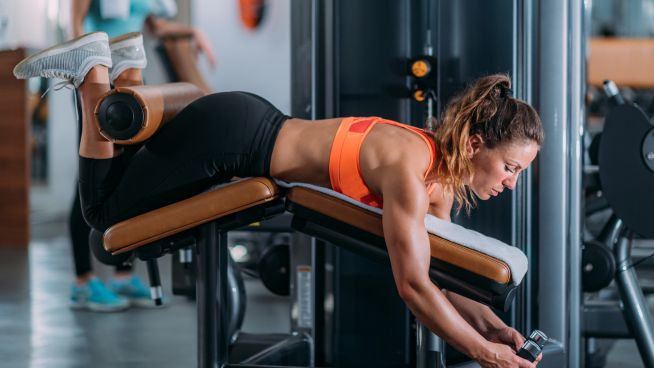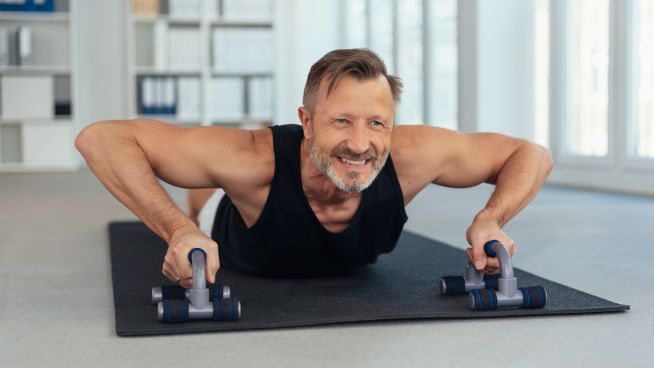Increase Your Flexibility in a Minute with These 4 Techniques!
Flexibility requires technique, not just stretching, to increase the range of motion and maximize the result. Stretching is just one part of the technique. Just stretching and stretching a muscle does not work to enhance your flexibility.
Follow these four techniques to develop flexibility instantly. I do mean immediately, under a minute!
Autogenic Inhibition
When a muscle contracts, there are sensory receptors called Golgi tendon organs (GTOs) located in the tendons near the muscle-tendon junction. These GTOs are sensitive to changes in muscle tension. When the tension in the muscle increases during a contraction, the GTOs are activated to reduce it, causing muscle relaxation. This protective mechanism reduces the risk of injury by preventing excessive force or tension within the muscle.
To utilize autogenic inhibition for flexibility training, you can follow these general steps:
Warm-up: Start with a general warm-up to increase muscle blood flow.
Relax Technique: Perform a static stretch for the muscle you want to target. Once you reach a point of mild discomfort, hold the stretch for about 10 seconds.
Relaxation: After you hold the resistance, the muscle will relax completely, allowing the stretch to deepen as the autogenic inhibition response kicks in.
Repeat the process, gradually moving deeper into the stretch with each cycle.
It’s important to note that autogenic inhibition stretching should be done gently and not cause pain.
Reciprocal Inhibition
Reciprocal Inhibition is like autogenic inhibition. The difference is you will contract the opposing muscle. For example, if you are stretching your hamstrings, you will contract your quads.
Warm-up: Start with a general warm-up to increase muscle blood flow.
Contract-Relax Technique: Before you start your stretch, contract the opposite muscle. For instance, contract your quads before and during stretching your hamstrings.
Relaxation: Once you reach the point where the hamstring stretch stops, relax the quad contraction and feel the stretch increase. Continue the cycle to deepen and enhance the stretch and increase the range of motion.
Repeat the process, gradually moving deeper into the stretch with each cycle.
Breathe into the Stretch
Inhaling as you move into a stretch initiates muscle contraction, while exhaling promotes muscle relaxation. You naturally enhance your range of motion and flexibility by rhythmically repeating this breathing cycle during your stretch.
The muscles gradually adapt to the tension, adjusting their position and resulting in a noticeable change in your range of motion. This breathing technique facilitates muscle relaxation and involves your core, contributing to a more effective stretch.
When you inhale, it stabilizes muscles, and when you exhale, it relaxes them. So, inhaling and exhaling enhances muscular flexibility.
As you cycle your breathing through the stretching pattern, it increases by adjusting, adapting, and changing the range.
Here are the steps to perform: breathe into the stretch.
Warm-up: Start with a general warm-up to increase muscle blood flow.
Inhale into the Stretch: Stretch the muscle until you feel the stretch stop. Inhale into your core at the point the stretch stopped. When the inhalation is complete, hold the breath for 5 seconds, and at the same time, stretch the muscle. Don’t force the stretch. It will be isometric.
Exhale and Stretch: After 5 seconds, exhale, and the stretch will open. You will move deeper into the stretch.
Repeat: Repeat the cycle until the stretching stops.
Stretch with Resistance
Flexibility is critical and pivotal for physical fitness and overall health and performance. While traditional static stretching remains a valuable practice, incorporating resistance into your stretching routine introduces a dynamic element that can significantly enhance flexibility and more.
This innovative approach uniquely engages muscles, prompting adaptations that increase the range of motion and strength and improve muscle elasticity.
Neuromuscular Adaptations
The nervous system is essential to improve flexibility. Adding resistance stimulates the Golgi tendon organs (GTOs), muscle spindles, and sensory receptors in the muscles and tendons. This stimulation prompts the nervous system to allow controlled muscle lengthening with tension, improving flexibility and strength.
Strengthens Muscles at Length
Stretching with resistance increases flexibility and helps strengthen the muscles through a full range of motion. This is particularly beneficial for functional flexibility, which involves flexibility within the context of strength and stability.
Improved Proprioception
Adding resistance requires greater body awareness and control. This improved proprioception (awareness of the body’s position in space) can improve overall movement patterns and coordination.
Here’s an example of how to add resistance to a stretch.
Deadlift with Stretch: You don’t need to use a heavyweight; use a weight at about 30-50% of your 1RM.
Starting Position: Stand tall. Keep your chest up, shoulders back, and a slight knee bend.
Hip Hinge: Hinge at your hips, keeping a slight bend in your knees. Maintain a straight back as your hip hinge.
Stretching Phase: Hinge forward slowly. Don’t make a fast motion so you can focus on feeling the stretch in your hamstrings and maintain tension. You should feel a lengthening sensation in the back of your legs.
Pause: When you feel a deep stretch in your hamstrings at the bottom of the movement, pause briefly for about 5 seconds to maintain muscle tension. After 5 seconds, you will feel an ease in the stretch and stretch deeper into the motion.
Return to Starting Position: Lift the barbell back up slowly by driving your hips forward and standing tall. Focus on using your hamstrings and glutes to bring your body back upright.
Repeat: Perform until the stretching stops or the range ends.
This variation combines the strength-building benefits of deadlifting with a focus on hamstring flexibility to increase the range of motion instantly. You can do this with any exercise and use other equipment like resistance bands.
Now, you can put all the techniques together into one to maximize your flexibility.
Check out my INSTANT STRENGTH book for total strength, speed, and power programs.
To maximize stability, mobility, and flexibility, check out my book, THE BALANCED BODY.
To see great exercises, methods, and techniques videos, subscribe to my YouTube channel, BALANCED BODY.
RECOMMENDED FOR YOU
MOST POPULAR
Increase Your Flexibility in a Minute with These 4 Techniques!
Flexibility requires technique, not just stretching, to increase the range of motion and maximize the result. Stretching is just one part of the technique. Just stretching and stretching a muscle does not work to enhance your flexibility.
Follow these four techniques to develop flexibility instantly. I do mean immediately, under a minute!
Autogenic Inhibition
When a muscle contracts, there are sensory receptors called Golgi tendon organs (GTOs) located in the tendons near the muscle-tendon junction. These GTOs are sensitive to changes in muscle tension. When the tension in the muscle increases during a contraction, the GTOs are activated to reduce it, causing muscle relaxation. This protective mechanism reduces the risk of injury by preventing excessive force or tension within the muscle.
To utilize autogenic inhibition for flexibility training, you can follow these general steps:
Warm-up: Start with a general warm-up to increase muscle blood flow.
Relax Technique: Perform a static stretch for the muscle you want to target. Once you reach a point of mild discomfort, hold the stretch for about 10 seconds.
Relaxation: After you hold the resistance, the muscle will relax completely, allowing the stretch to deepen as the autogenic inhibition response kicks in.
Repeat the process, gradually moving deeper into the stretch with each cycle.
It’s important to note that autogenic inhibition stretching should be done gently and not cause pain.
Reciprocal Inhibition
Reciprocal Inhibition is like autogenic inhibition. The difference is you will contract the opposing muscle. For example, if you are stretching your hamstrings, you will contract your quads.
Warm-up: Start with a general warm-up to increase muscle blood flow.
Contract-Relax Technique: Before you start your stretch, contract the opposite muscle. For instance, contract your quads before and during stretching your hamstrings.
Relaxation: Once you reach the point where the hamstring stretch stops, relax the quad contraction and feel the stretch increase. Continue the cycle to deepen and enhance the stretch and increase the range of motion.
Repeat the process, gradually moving deeper into the stretch with each cycle.
Breathe into the Stretch
Inhaling as you move into a stretch initiates muscle contraction, while exhaling promotes muscle relaxation. You naturally enhance your range of motion and flexibility by rhythmically repeating this breathing cycle during your stretch.
The muscles gradually adapt to the tension, adjusting their position and resulting in a noticeable change in your range of motion. This breathing technique facilitates muscle relaxation and involves your core, contributing to a more effective stretch.
When you inhale, it stabilizes muscles, and when you exhale, it relaxes them. So, inhaling and exhaling enhances muscular flexibility.
As you cycle your breathing through the stretching pattern, it increases by adjusting, adapting, and changing the range.
Here are the steps to perform: breathe into the stretch.
Warm-up: Start with a general warm-up to increase muscle blood flow.
Inhale into the Stretch: Stretch the muscle until you feel the stretch stop. Inhale into your core at the point the stretch stopped. When the inhalation is complete, hold the breath for 5 seconds, and at the same time, stretch the muscle. Don’t force the stretch. It will be isometric.
Exhale and Stretch: After 5 seconds, exhale, and the stretch will open. You will move deeper into the stretch.
Repeat: Repeat the cycle until the stretching stops.
Stretch with Resistance
Flexibility is critical and pivotal for physical fitness and overall health and performance. While traditional static stretching remains a valuable practice, incorporating resistance into your stretching routine introduces a dynamic element that can significantly enhance flexibility and more.
This innovative approach uniquely engages muscles, prompting adaptations that increase the range of motion and strength and improve muscle elasticity.
Neuromuscular Adaptations
The nervous system is essential to improve flexibility. Adding resistance stimulates the Golgi tendon organs (GTOs), muscle spindles, and sensory receptors in the muscles and tendons. This stimulation prompts the nervous system to allow controlled muscle lengthening with tension, improving flexibility and strength.
Strengthens Muscles at Length
Stretching with resistance increases flexibility and helps strengthen the muscles through a full range of motion. This is particularly beneficial for functional flexibility, which involves flexibility within the context of strength and stability.
Improved Proprioception
Adding resistance requires greater body awareness and control. This improved proprioception (awareness of the body’s position in space) can improve overall movement patterns and coordination.
Here’s an example of how to add resistance to a stretch.
Deadlift with Stretch: You don’t need to use a heavyweight; use a weight at about 30-50% of your 1RM.
Starting Position: Stand tall. Keep your chest up, shoulders back, and a slight knee bend.
Hip Hinge: Hinge at your hips, keeping a slight bend in your knees. Maintain a straight back as your hip hinge.
Stretching Phase: Hinge forward slowly. Don’t make a fast motion so you can focus on feeling the stretch in your hamstrings and maintain tension. You should feel a lengthening sensation in the back of your legs.
Pause: When you feel a deep stretch in your hamstrings at the bottom of the movement, pause briefly for about 5 seconds to maintain muscle tension. After 5 seconds, you will feel an ease in the stretch and stretch deeper into the motion.
Return to Starting Position: Lift the barbell back up slowly by driving your hips forward and standing tall. Focus on using your hamstrings and glutes to bring your body back upright.
Repeat: Perform until the stretching stops or the range ends.
This variation combines the strength-building benefits of deadlifting with a focus on hamstring flexibility to increase the range of motion instantly. You can do this with any exercise and use other equipment like resistance bands.
Now, you can put all the techniques together into one to maximize your flexibility.
Check out my INSTANT STRENGTH book for total strength, speed, and power programs.
To maximize stability, mobility, and flexibility, check out my book, THE BALANCED BODY.
To see great exercises, methods, and techniques videos, subscribe to my YouTube channel, BALANCED BODY.












